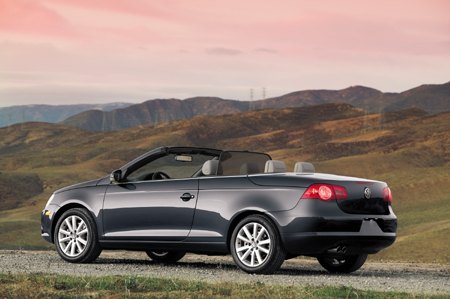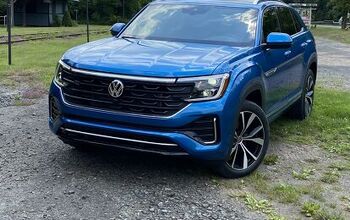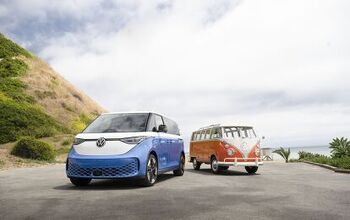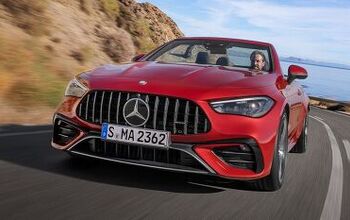Volkswagen Eos Review
There is no way to overstate the appeal of the new Volkswagen Eos’ folding hardtop. I sat inside the car for ten minutes, opening and closing the lid, marveling at the mechanism’s precision and design. What kind of mind can develop something that folds and unfolds with such infinite grace? If you like to visit high speed factories spitting out hundreds of widgets per minute, filling them with liquids and shrink wrapping them in three swift motions, then you will never tire of lowering and raising the Eos’ five-piece hardtop. As for the rest of Vee Dub’s CSC (coupe-sunroof-convertible), it’s danger, boredom ahead.
All the time, effort and money VW’s engineers spent creating and manufacturing the Eos’ hardtop must have been scrimped from the company’s design department. Although there’s plenty of concave and convex “flame surfacing” in the usual places (wheel arches, door bottoms), there’s nothing even mildly warm about the Eos’ overall look. While the detailing takes German minimalism to the next level (dull and insipid), the proportions are the real passion killer. The overhangs are grossly mismatched, the ascending beltline says “tip-toeing bathtub” and the rearwards sloping rear deck is just plain wrong. At best (i.e. after you buy one), the Eos is “cute.” For those of us who remain on the sidelines, "homely and unlovable" is closer to the truth.
As befits a car that was shown as a concept just 18 months ago, the Eos’ interior is a parts bin special. Although the fascia is all new, all the bits slotted in are standard Golf fare— and none the worse for it. It’s a clean look with faultless ergonomics, from cosseting chairs to simple controls. Our tester’s Sport package (about $3500) adds some much needed spizzarkle– aluminum trim and wikkid dials– to the cabin’s otherwise dour demeanor. There aren’t a lot of high tech toys, but the [optional] satellite radio gets channeled through an [optional] mini Marshall stack and the [optional] corner steering xenon lighting makes drivers feel positively Lexian.
Pistonheads note: the folding hardtop VW Eos is no one trick pony. Provided you stump-up for VW’s dual shift gearbox (DSG), it’s a one-and-a-half trick pony. The superb paddle shift system, which has transformed ugly ducklings like the VW GTI and Audi A3 into F1 soaring Eagles, turns the Eos into a runt swan. Credit the extra weight of the hardtop top, its motor and the chassis strengthening needed to maintain torsional rigidity. It does nothing for the car’s dynamics, except spoil them.
VW’s press site pegs the Eos’ curb weight at 3503 lbs. That would make the Eos (which sits on a modified Passat platform) just 195 pounds heavier than a GTI. It feels three times that. Even under full throttle, the DSG labors to make anything happen. The razor-sharp small VW driving experience is decidedly dumbed down. Our tester had the base engine: a 2.0-liter, 200hp, turbocharged four. This mill, so willing and frisky in all the other VW/Audi executions, feels overwhelmed and peaky in this application. If you want to buy this top– I mean car, wait for September, when the factory starts building the Eos with a 250hp V6.
Of course, the Eos’ ponderousness steals more than the accelerative joy normally derived from this engine and transmission combination. The “I can’t believe this is a front driver” handling experience from the GTI is lost as well. Understeer is the party guest from Hell, arriving early and staying late. The props top also seems to unbalance the equation vertically; the Eos navigates curves like an ungainly and top heavy SUV. In addition to the nautical motions, you also get a maritime soundtrack: the top creaks and groans over rough patches like an old wooden schooner.
If the Jetta is all grown up, the Eos is an octogenarian. Its lethargic performance and high quality materials highlight the blue rinse effect. The pricing punctuates these observations. The 2.0-liter Eos starts under $30k, and quickly ascends in the high 30’s. The 3.2 will easily break $40k. Hardtop or no, the GTI is looking more and more like the pick of the litter.
Anyway, the Eos is clearly another “lifestyle” Volkswagen aimed at the empty nest/trustafarian market. While the Eos’ retractable hardtop is nothing new from the likes of the Mercedes (SL/SLK), we’re grateful that the new Vee Dub brings Germany's open and shut case to the masses. If Wolfsburg had attached their wundertop to a more attractive package, they would have had an instant classic. Instead, they’ve built a highly polished though dynamically dull machine whose appeal— and sales— will rely almost entirely on the novelty of its hood. Will that party trick be enough to move the metal? Absolutely.
More by Jay Shoemaker
Latest Car Reviews
Read moreLatest Product Reviews
Read moreRecent Comments
- Tassos Obsolete relic is NOT a used car.It might have attracted some buyers in ITS DAY, 1985, 40 years ago, but NOT today, unless you are a damned fool.
- Stan Reither Jr. Part throttle efficiency was mentioned earlier in a postThis type of reciprocating engine opens the door to achieve(slightly) variable stroke which would provide variable mechanical compression ratio adjustments for high vacuum (light load) or boost(power) conditions IMO
- Joe65688619 Keep in mind some of these suppliers are not just supplying parts, but assembled components (easy example is transmissions). But there are far more, and the more they are electronically connected and integrated with rest of the platform the more complex to design, engineer, and manufacture. Most contract manufacturers don't make a lot of money in the design and engineering space because their customers to that. Commodity components can be sourced anywhere, but there are only a handful of contract manufacturers (usually diversified companies that build all kinds of stuff for other brands) can engineer and build the more complex components, especially with electronics. Every single new car I've purchased in the last few years has had some sort of electronic component issue: Infinti (battery drain caused by software bug and poorly grounded wires), Acura (radio hiss, pops, burps, dash and infotainment screens occasionally throw errors and the ignition must be killed to reboot them, voice nav, whether using the car's system or CarPlay can't seem to make up its mind as to which speakers to use and how loud, even using the same app on the same trip - I almost jumped in my seat once), GMC drivetrain EMF causing a whine in the speakers that even when "off" that phased with engine RPM), Nissan (didn't have issues until 120K miles, but occassionally blew fuses for interior components - likely not a manufacturing defect other than a short developed somewhere, but on a high-mileage car that was mechanically sound was too expensive to fix (a lot of trial and error and tracing connections = labor costs). What I suspect will happen is that only the largest commodity suppliers that can really leverage their supply chain will remain, and for the more complex components (think bumper assemblies or the electronics for them supporting all kinds of sensors) will likley consolidate to a handful of manufacturers who may eventually specialize in what they produce. This is part of the reason why seemingly minor crashes cost so much - an auto brand does nst have the parts on hand to replace an integrated sensor , nor the expertice as they never built them, but bought them). And their suppliers, in attempt to cut costs, build them in way that is cheap to manufacture (not necessarily poorly bulit) but difficult to replace without swapping entire assemblies or units).I've love to see an article on repair costs and how those are impacting insurance rates. You almost need gap insurance now because of how quickly cars depreciate yet remain expensive to fix (orders more to originally build, in some cases). No way I would buy a CyberTruck - don't want one, but if I did, this would stop me. And it's not just EVs.
- Joe65688619 I agree there should be more sedans, but recognize the trend. There's still a market for performance oriented-drivers. IMHO a low budget sedan will always be outsold by a low budget SUV. But a sports sedan, or a well executed mid-level sedan (the Accord and Camry) work. Smaller market for large sedans except I think for an older population. What I'm hoping to see is some consolidation across brands - the TLX for example is not selling well, but if it was offered only in the up-level configurations it would not be competing with it's Honda sibling. I know that makes the market smaller and niche, but that was the original purpose of the "luxury" brands - badge-engineering an existing platform at a relatively lower cost than a different car and sell it with a higher margin for buyers willing and able to pay for them. Also creates some "brand cachet." But smart buyers know that simple badging and slightly better interiors are usually not worth the cost. Put the innovative tech in the higher-end brands first, differentiate they drivetrain so it's "better" (the RDX sells well for Acura, same motor and tranmission, added turbo which makes a notable difference compared to the CRV). The sedan in many Western European countries is the "family car" as opposed to micro and compact crossovers (which still sell big, but can usually seat no more than a compact sedan).
- Jonathan IMO the hatchback sedans like the Audi A5 Sportback, the Kia Stinger, and the already gone Buick Sportback are the answer to SUVs. The A5 and the AWD version of the Stinger being the better overall option IMO. I drive the A5, and love the depth and size of the trunk space as well as the low lift over. I've yet to find anything I need to carry that I can't, although I admit I don't carry things like drywall, building materials, etc. However, add in the fun to drive handling characteristics, there's almost no SUV that compares.





































Comments
Join the conversation
I'd been planning to drive one of these. But when I went to the dealer a few weeks ago, I had to choose between a manual GTI and DSG GLI. I'd already driven a manual GLI, so I went with the DSG car. Has anyone driven both the GLI and GTI? Do they feel any different?
I checked this site in the hopes of useful reviews in search of a new car. What I feel I found is a site organized by a group of testosterone driven teens. The language is trite with pre-packaged phrases, competition for sarcasm the rule. "My dog is better than your dog" disguised as a review. Those who can dig through the "review?" searching for some insight best not question it lest they be driven back by insults. I thought I was on CNet where juveniles argue over who's cell phones or mp3 players "rule". Nothing I found useful.